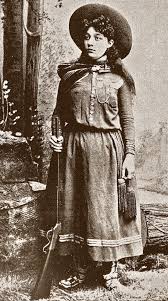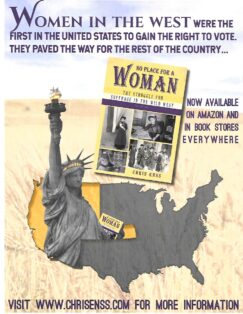1865 – President Abraham Lincoln was assassinated by John Wilkes Booth at Ford’s Theatre in Washington, D.C.
Journal Notes
Wedding Day for the Lillies
Enter now to win a copy of
The Sharpshooter and the Showman: May Lillie, Pawnee Bill, and their Wild West Show

Newlyweds May Manning and Gordon Lillie watched the countryside pass by from a window of the passenger car onboard their Kansas bound train. A brilliant sun shined down on the open landscape. The gentle undulating plains were broken occasionally by valleys and hills. Those hills rolled like a casually laid quilt, rising, and falling in soft waves. May was mesmerized by the grand scenery. Gordon, who had seen the view often and like others who witnessed it routinely took it for granted, admired the terrain as though seeing it for the first time. May’s enthusiasm was infectious.
The Lillies married at the Siloam Methodist Church of Philadelphia on August 31, 1886. May’s parents had made all the arrangements including selecting the location for the wedding. She had been christened in the Siloam Church and her mother and father believed it was the appropriate setting. Many guests attended the nuptials and showered the couple with sincere best wishes. Gordon considered marrying May a remarkable “turning point” in his life.
An hour after the pair exchanged vows, they were off to Gordon’s ranch near Wellington, Kansas. “I was now Pawnee Bill’s wife,” May explained to reporters in 1936, “and in the words of Ruth, ‘Whither thou goest, I will go,’ was my motto.” Seventeen-year-old May was both excited and nervous about leaving home. She shared her trepidation with her husband. Gordon wanted to do all he could to put her mind at ease.
“May had misgivings about the West,” he recalled in his memoirs. “She was going into a new country where there were none of the society and conveniences of Philadelphia and I didn’t want her to be disappointed. When the train reached Wichita, I telegraphed some friends that I would reach Wellington that evening and I wanted them to make our arrival as exciting as possible.
“Fifty or sixty gentlemen and ladies turned out with a band to receive us and gave us a serenade. When we got off the train, May looked around and said, ‘Where’s the carriage?’ A spring wagon rattled around the corner of the depot and I said, ‘That’s it.’ We all got into the wagon and drove to South Wellington to the home of my sister, Effie, who gave us a fine reception.”
Local newspapers featured articles about the newly wedded couple expressing their good wishes and welcoming May to the area. “Gordon Lilly [sic], called ‘Pawnee Bill’, by his acquaintances of this city, arrived yesterday with his bride,” read an article in the September 7, 1886, edition of the Wellington Sunday Press. “He has received an appointment in the territory and after taking in the fair will repair to his destination.”
The September 7, 1886, edition of the Daily Postal Card also reported on the happy occasion. “Gordon Lilly, [sic] ‘Pawnee Bill,’ formerly of Wellington and well known in the city, a noted Indian interpreter, but lately of Buffalo Bill’s Wild West company, arrived in the city yesterday from Philadelphia, accompanied by his bride, of a few days, a charming lady whose maiden name was Mary E. Manning. She is a cousin of Secretary Manning, and her father is a practicing physician in the Quaker City.
“Mr. Lilly and wife proceeded yesterday to the home of the former thirteen miles southeast of the city. Gordon has received a government appointment and will be stationed in the Indian territory. He will hence soon tie himself with his wife to that country of which he is so familiar.”
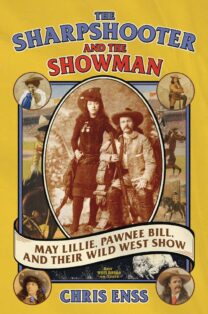
Sharpshooter and the Showman
I'm looking forward to hearing from you! Please fill out this form and I will get in touch with you if you are the winner.
Join my email news list to enter the giveaway.
"*" indicates required fields
To learn more about the famous Lillies read The Sharpshooter and the Showman
When May Manning Met Pawnee Bill
Enter now to win a copy of
The Sharpshooter and the Showman
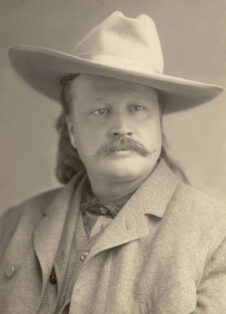
In July 1885, May and her other sister, Elmira Bronde and her newborn baby, were spending the day together, no doubt discussing the future, when they decided to attend Buffalo Bill Cody’s Wild West Show in Philadelphia. More than nine thousand people had the same idea and flowed to the Gentleman’s Driving Park to watch the performance. The experience proved to be an enlightening one for May. She went to Cody’s program for a glimpse at the people and animals that could only routinely be seen west of the Mississippi, and it was then she found her life’s calling.
May and her sister sat in the stands along with a hundred Indian children from the Lincoln Institute Orphanage in the heart of Philadelphia. Before the show began the boys and girls sat quietly, eating ginger cakes and other treats. When the program opened, and Indian braves galloped by whooping and brandishing their arms, the children’s eyes were wide with amazement. May and Elmira were equally enthralled. The trick riding and roping acts, the sharpshooters, dancers, and musicians told a story of how dreams could flourish when you marry passion with talent.
Among the entertainers working in the arena with the other acts was twenty-five-year-old horseback rider and trick shooter Pawnee Bill. He’d caught a glimpse of May prior to the start of the show. He was waiting in front of the main tent with the other cast members when he noticed the diminutive teenager with pigtails and a charming smile. Gordon looked unlike any man she’d ever seen. He had long hair, was dressed in buckskin britches and a fringed jacket, and wore a sombrero. He tipped his hat to her when their eyes met. She stifled a giggle as she hurried along after her sister to find their seats. Gordon later noted in his biography that he thought May was the prettiest girl he’d ever seen. May’s first thought when she saw him was, “What a funny man.”
Gordon was smitten with May the moment she caught his eye. He sent her a note letting her know that he’d like to meet her after the show. “It was love at first sight,” he later wrote in his memoirs, “and I knew that she was the girl for me.”

To learn more about May and Gordon read
The Sharpshooter and the Showman: May Lillie, Pawnee Bill, and their Wild West Show
Sharpshooter and the Showman
I'm looking forward to hearing from you! Please fill out this form and I will get in touch with you if you are the winner.
Join my email news list to enter the giveaway.
"*" indicates required fields
A Great Adventure
Enter now to win a copy of
The Sharpshooter and the Showman: Pawnee Bill, May Lillie, and their Wild West Show
William Shakespeare once wrote, “I would not wish any companion in the world but you.” When writing about the lives of frontiersman, entrepreneur, and performer Major Gordon Lillie, better known as Pawnee Bill, and his courageous, sharpshooting, equestrian wife Mary “May” Manning, it is easy to see how the Bard’s quote applied to the couple.
Married for more than fifty years, the Lillies launched a historic Wild West Show together and traveled the world. They were the subject of Dime Novels and films and, in between performing, built a magnificent home on their Oklahoma buffalo ranch. They shared the thrill of entertaining royals in foreign countries and of watching the construction of their house on Blue Hawk Peak, as well as the disappointment of being betrayed by a business partner and the heartbreaking death of their children.
When May met Gordon in the mid-1800s, becoming part of a Wild West Show wasn’t a consideration. Pawnee Bill was working with Buffalo Bill Cody’s program at that time. Wild West Shows focused on recreating scenes from the American frontier, and they were immensely popular. The cast included cowboys and Indians, trick riders and ropers, wagon trains and stagecoaches, as well as horses and buffalo. It amused and educated audiences primarily in the East, providing them with a look at what the West was like before being civilized.
Within a few years of Pawnee Bill participating in Cody’s show, he had his own on the road, and with him Mrs. Lillie was one of the riders and billed as the “World’s Champion Lady Rider and Rifle Shot.” On the road and on the billboards she was known as Miss May Lillie during her entire show career. The Pawnee Bill Show toured Europe and while over there, May gave private rifle shot exhibitions for many of the nobility. She was known throughout America for her skill with a gun and was one of the chief attractions of their show.
The Lillies were on tour with their Wild West program every season for more than twenty years. The first year of their traveling show wasn’t a financial success, but the pair managed to alter the program to include hundreds of horses, eighty plus Indians, fifty cowboys and Mexican vaqueros, trappers, hunters, scouts, and the famous Annie Oakley.
When Gordon decided to combine Lillies’ show with Buffalo Bill Cody’s, May chose to remain at the ranch and focus her attention on their growing buffalo herd. Both she and Gordon had long been aware of the fast disappearance of the great plains bison and became active conservationists in buffalo preservation on a national level.
In addition to running the ranch, May had an active church and social life and was involved with the betterment of the community, helping to build the first sanitorium in the region. She was known as a charming hostess and when Gordon’s business dealings came to an end and he was home more regularly, they frequently entertained writers, political leaders, and film stars. In the 1930s, the couple expanded their ranch to include a reproduction of an Old West town, consisting of a blacksmith shop, barns, and several other such buildings found in frontier settlements across the West. The addition attracted large crowds to their annual rodeo.
Gordon and May’s home was a continual gathering spot for many well-known people around the world. Built in 1910, the location is now a historic site and museum. Just as they had between 1911 and 1942, visitors still travel to the Lillies’ ranch to admire the grand fourteen-room structure and spend time reminiscing about the pair’s contribution to the show business industry.
Life in the Far West is the story of the Lillies’ five decades of marital endurance, how they met, the creation of the renowned Wild West Show, their devotion to one another during their trials, and their individual endeavors apart from performing. Pawnee Bill and May Lillie are among the West’s great power couples along with duos such as Annie Oakley and Frank Butler, John Fremont and Jessie Benton, and Marshal Bill Tilghman and Zoe Statton. The Lillies were devoted to their work, their home, and most importantly to one another. They were one another’s greatest adventure.

Sharpshooter and the Showman
I'm looking forward to hearing from you! Please fill out this form and I will get in touch with you if you are the winner.
Join my email news list to enter the giveaway.
"*" indicates required fields
To learn more about the Lillies read The Sharpshooter and the Showman
The Sharpshooter and the Showman Arrives April 2
Enter now to win a copy of
The Sharpshooter and the Showman

Step into the exhilarating world of Wild West entertainment with The Sharpshooter and the Showman, a riveting new book that explores the remarkable lives of May Manning Lillie and Gordon “Pawnee Bill” Lillie. As trailblazers in the world of Wild West shows, the Lillies built a spectacle that rivaled even Buffalo Bill Cody’s legendary performances, captivating audiences across the United States and Europe.
From May’s transformation from a Philadelphia Quaker to a fearless sharpshooter to Gordon’s deep connection with the Pawnee people, their story is one of ambition, resilience, and innovation. The Sharpshooter and the Showman reveals the struggles and triumphs of their show business empire, their commitment to fair treatment of performers, and their lasting impact on Western heritage.
The era of Wild West Shows revealed America at its most enterprising. Join Pawnee Bill and May Manning Lillie as they embark on a wild, sometimes tragic, but often joyful ride together. Theirs was a love story that rose to every challenge and seized every opportunity that came their way. They made headlines in newspapers, won fans among European royalty, and captured the heart of Americans from New England to California. This is their remarkable—and true—story.
The Sharpshooter and the Showman: May Lillie, Pawnee Bill, and Their Wild West Show written by New York Times bestselling author Chris Enss who has earned numerous awards including nine Will Rogers Medallions, two Laura Downing Journalism award, and the Willa Cather Award from Women Writing the West.
“After reading The Sharpshooter and the Showman: May Lillie, Pawnee Bill, and their Wild West Show, I regret not being able to see Pawnee Bill and May Lillie leading the Wild West Show into the arena. What a great book! I was captivated by the Lillie’s story, a true partnership in every sense of the word.”
– Michael D. Williams, director of the Oklahoma Territorial Museum and Carnegie Library
“Without a shade of exaggeration, this Wild West ride of Pawnee Bill and May Lillie gave me goosebumps! I was hooked just reading the introduction.”
– Lynn Eldridge, award-winning romance author of Hearts and Mountains
“Pawnee Bill and his sharpshooting wife, May Lillie, brought the wonder of different cultures, including the Wild West, to the USA and Europe. Their long marriage was a miracle of understanding, deep love, and support that allowed them to reach their dreams and keep creating new ones. Go on the adventure with them as they overcome tragedy, and build extraordinary bonds, from their ranch in Oklahoma to European royalty. Enjoy this fun and inspired read!”
– Meredith Blevins, eight-time Magellan gold, award-winning travel writer, award-winning author of The Hummingbird Wizard
“In The Sharpshooter and the Showman, Author Chris Enss shows how May Lillie and Pawnee Bill not only recreated the Wild West but also lived it to the fullest. A powerful and enthralling dual biography written by a masterful historian and writer.”
– Preston Lewis and Harriet Kocher Lewis, award-winning authors of Pintsized Pioneers: Taming the Frontier, One Chore at a Time
The Sharpshooter and the Showman: May Lillie, Pawnee Bill, and their Wild West Show is available at local retailers, Amazon.com, Barnes & Noble.com, and from Farcountry Press at farcountrypress.com.
Duck Fat and Happiness
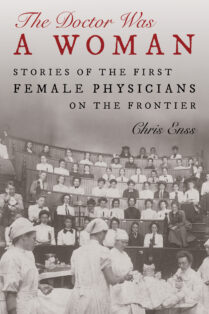
I’m traveling tomorrow to the Blackhawk Museum to give a presentation about women of the West and specifically about pioneer women physicians. I’m excited to share what I learned researching and writing the book The Doctor Was A Woman. I couldn’t help but notice a theme that ran through the majority of the stories I found. As far back as 1890 in the Gold Country, women patients were seeking doctors’ recommendations on how to stop the aging process. Women of a certain age were hoping to find a crème or a lotion to remove the dark circles under their eyes and reduce wrinkles on their face and neck.
The invention of the “bust improver” in 1887, with pads of assorted sizes that could be inserted into a slit in the fabric, solved any enhancement issues. The corset helped women who wanted a waist-measurement that did not exceed the number of years of her age was a problem solver as well. How to get rid of dark circles and wrinkles was still a mystery.
Some doctors suggested women slather their face with donkey milk or duck fat to eliminate crow’s feet and turkey’s neck. Women complained the prescription did nothing to eradicate the wrinkles. It did, however, attract cats. A trade off most ladies disliked immensely.
Advertisements for Pears Soap featuring the beautiful actress Lilly Langtry, promised women who used the product a “nice youthful complexion, young looking hands, a reduction in wrinkles, and happiness galore.” In the print ads, Lilly boasted about the wonderful results she had washing with Pears Soap daily and encouraged women with stubborn wrinkles to wash their face two and three times a day. Langtry was a successful, wealthy, twenty-eight-year-old and many women were annoyed that someone who obviously didn’t struggle with wrinkles at her age would be giving advice on how to halt the process or gain happiness.
I feel the same way every time I see a commercial about wrinkle cream starring a teenager. Or hear a twenty something model lecture me about avoiding meat and eating only lawn clippings and Greek yogurt. What makes advertisers think the opinion of these supermodels has more weight or importance simply because they happened to hit the pick six in the genetic lottery?
It seems our entire existence is spent yearning for what we don’t have, and we’re convinced that whatever it is we’re missing is the one thing keeping us from perfect bliss. Which the makeup manufacturers would have you believe resembles a Revlon commercial where everyone is in a thong bikini cavorting on the beach while applying rejuvenating cream on their nonexistent drying pores. I don’t think it’s possible to have baby dolphin smooth skin unless you’re a dolphin. And I personally look like a sumo wrestler in a thong.
And as for happiness… What makes people happy anyway? I’ve concluded that most people are only really happy not when something good happens to them, but when something bad doesn’t happen to them.
Happiness is not settling for less, but just not being miserable with what is. I have always lived by the creed that it’s not the approval or accolades or possessions that make you smile, but simply making the left turn even though you were the third car in the intersection.
Now, where’s that duck fat?
Votes for Women
The Suffragents
Enter now to win a copy of
No Place for a Woman: The Struggle for Suffrage in the Wild West
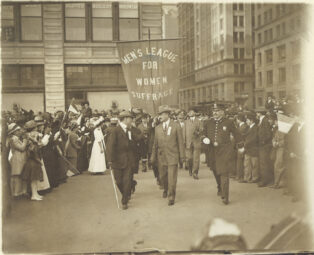
In 1911, actress, playwright, and suffragette Vida Sutton coined the term “suffragent.” A suffragent referred to a man who was big enough to see that women should be given the right to vote. “This type of man is one of the most powerful allies of the cause of women,” Vida explained to a reporter for the New York Times. “He not only does no hinder but does all that he can to help.”
From the time the woman suffrage movement was first launched in 1846, there were many prominent suffragents who played significant roles in helping women secure the right to vote.
At the urging of Elizabeth Cady Stanton, California Senator Aaron Augustus Sargent introduced the first federal woman suffrage amendment in 1878. The amendment was reintroduced in every succeeding Congress until adopted in 1920. “I believe the time is rapidly coming when all men will conclude that it is no longer wise or judicious to exclude one half of the intelligence and more than one half of the virtue of the people from the ballot box,” Sargent remarked in April 1878.
San Francisco mayor Adolph Sutro echoed those sentiments in March 1896. “I believe equality is the basic principle of our government – hence women should assume all the responsibilities that arise out of her moral and mental endowments as a citizen,” Sutro told the San Francisco Chronicle. “Woman’s advent as a voter will be the means through which the government may be perpetuated, as embodying justice, equality, and righteousness.”
Frederick Douglass, American abolitionist, orator and lecturer, was present at the Seneca Falls Women’s Rights Convention of 1848 and advocated for women’s rights along with abolition and the rights of African Americans. At a meeting of the National Council of Women in 1895, he reminded an enthusiastic crowd of what he had written about the issue in 1848. “A discussion of the rights of animals would be regarded with far more complacency by many of what are called the wise and the good of our land than would be a discussion of the rights of women… We hold women to be justly entitled to all we claim for man.”

No Place for a Woman 3
I'm looking forward to hearing from you! Please fill out this form and I will get in touch with you if you are the winner.
Join my email news list to enter the giveaway.
"*" indicates required fields
To learn more about the suffragents read
No Place for a Woman: The Struggle for Suffrage in the Wild West
Heroines of History
I’m slow on the uptake sometimes. I’m generally so focus on my job writing and telling others about the amazing work women of the American frontier did to settle the wild west, I miss when people are insulting me. Since January, I’ve participated in two speaking events with women who genuinely believe females are just a bit better off now than they we were before the 19th Amendment was ratified in August 1920.
Prior to being introduced as the keynote speaker at one event, the host announced how she’d hoped the gathering would have been a celebration of the election of the first woman president of the United States. The audience groaned with sadness they weren’t celebrating that fact. The host then remarked how ashamed all women who did not vote for Kamala Harris should be. “We need a woman in office,” she insisted, “and women need to vote for the female candidate that is running.”
I am sure the gathering heard my eyes rolling. It was a ridiculous statement and one that took me by surprise. The notion that I’m supposed to vote for someone solely on the basis that they were a woman and ignore whether or not she was a worthy candidate is outrageous. I’d be happy to vote for a woman, but she has to be qualified. Could a woman act cooly and decisively in the event of a national crisis? It depends on the woman. Tulsi Gabbard, yes. Meryl Streep, no. And I like Meryl Streep.
Questions from the audience after my talk centered around what I thought about women in the America struggling to get ahead like they did between 1860 and 1900. I couldn’t produce a single example of women in 2025 NOT having the opportunity to pursue whatever they please in this country. In the early West, women’s choices were limited. They could be a teacher, laundress, or prostitute. How those upper middleclass women could think for a minute that they lacked opportunity today was staggering to me. Of course, none of them could provide any concrete examples to support their argument.
The most recent book panel I participated was just as silly. This time the moderator of the talk wanted to know from the authors on the panel about women who dared to speak. The implication was that in America in 2025, women are still shrinking violets with no voice and no one to hear them when they do speak out. Again, if we were in Afghanistan, I’d agree. But not here and not now. It’s difficult to have a discussion with women who honestly believe they have been objectified by men and then watch at least one of those women walk back to their booth at the book festival I was attending called “Hotties of History.”
I have come to this conclusion. It takes zero politically correct so-called victims to screw in a light bulb, because they are perpetually in the dark.
The women I write about in No Place for a Woman: The Struggle for Suffrage in the Wild West rose above their circumstances to fight for seventy years to gain the right to vote. Those women are the true heroines and worth admiring.
Enter to win a copy of No Place for a Woman.
No Place for a Woman 3
I'm looking forward to hearing from you! Please fill out this form and I will get in touch with you if you are the winner.
Join my email news list to enter the giveaway.
"*" indicates required fields

